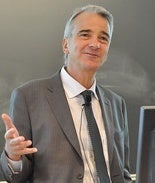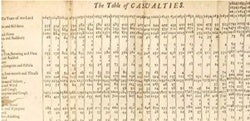September 24, 2012 — Can an academic discipline have an exact birthday? Alfredo Morabia thinks so, and he believes that epidemiology’s 350th birthday is 2012—because 1662 is the year that an Englishman named John Graunt compiled, for the first time ever, 50 years’ worth of birth and death statistics from London that revealed trends about population health.
Morabia, a professor of epidemiology at Queens College, City University of New York, and at Columbia University’s Mailman School of Public Health, spoke about epidemiology’s history at a talk sponsored by the Harvard School of Public Health Department of Epidemiology on September 12, 2012.
Changing views of disease
Epidemiology is the study of the incidence and prevalence of disease in large populations, and it focuses on the sources and causes of epidemics. But up until the 17th century it seemed that medicine was powerless against epidemics, Morabia said. The reason? Since the time of the ancient Greeks, doctors had viewed disease as an imbalance of one of the four bodily fluids, or “humors”—blood, phlegm, and black and yellow bile. This concept, focused on imbalances within individuals, prevented doctors and scientists from seeing the bigger population health picture, Morabia said.
However, the bubonic plague, which had come to Europe in the 1300s and had recurred periodically for three centuries, led to a major change in the way disease was viewed. Outbreaks prompted people to flee from disease-ridden areas, but they often left too late, not realizing the danger until many had died. This often caused chaos, riots, and thefts. Heads of state, already fearful of revolt and revolution during an extremely volatile period in history, wanted to quell the panic.
So the King of England made an important decision. “He decided to collect population data for the first time, so that when plague was around, people could know where it was, and therefore plan and escape in a very orderly way,” said Morabia.
That decision turned out to be a key phenomenon in the history of epidemiology. Information on the number and location of plague-related deaths was printed and distributed each week. The Church was enlisted to help gather this crucial information. Parish clerks, already recording births and deaths, were asked to specify which deaths were from plague. To obtain this information, the church sent matrons into individual homes. The women could easily spot plague-related deaths because of the telltale swollen or ruptured lesions on the bodies.
Birth of a table
In his book, titled Natural and Political Observations, Graunt, an amateur scientist, compiled 50 years’ worth of this data in a table listing deaths and their causes. “It was the first table ever with population data on health,” Morabia said. “Graunt had to explain to the reader how to read it, because they had never seen anything like it before.”
This compilation of population health data was a huge step forward. At the same time, other concepts were emerging that were key to new ways of thinking about health. Francis Bacon, a scientist and philosopher in England, came up with the idea of “exposures”—of health being influenced by factors such as heredity, height and weight, and age. English physician Thomas Sydenham developed the notion of disease as groups of symptoms that can afflict many people in the same way. And René Descartes, a French philosopher and mathematician, emphasized the importance of trusting evidence as opposed to perceptions or beliefs.
The work of these thinkers, along with Graunt’s data compilations, were key to propelling the new study of epidemics—epidemiology. The term was coined in the mid-19th century.
“The movement from thinking about individual health to thinking about population health occurred over a very short period of time, with new population data and with revolutions in science, philosophy, and medicine,” Morabia said. “That’s why I think 1662 is the exact birthday of our discipline. From then on, the discipline would grow methodologically and conceptually. It was like a big bang.”
–Karen Feldscher

